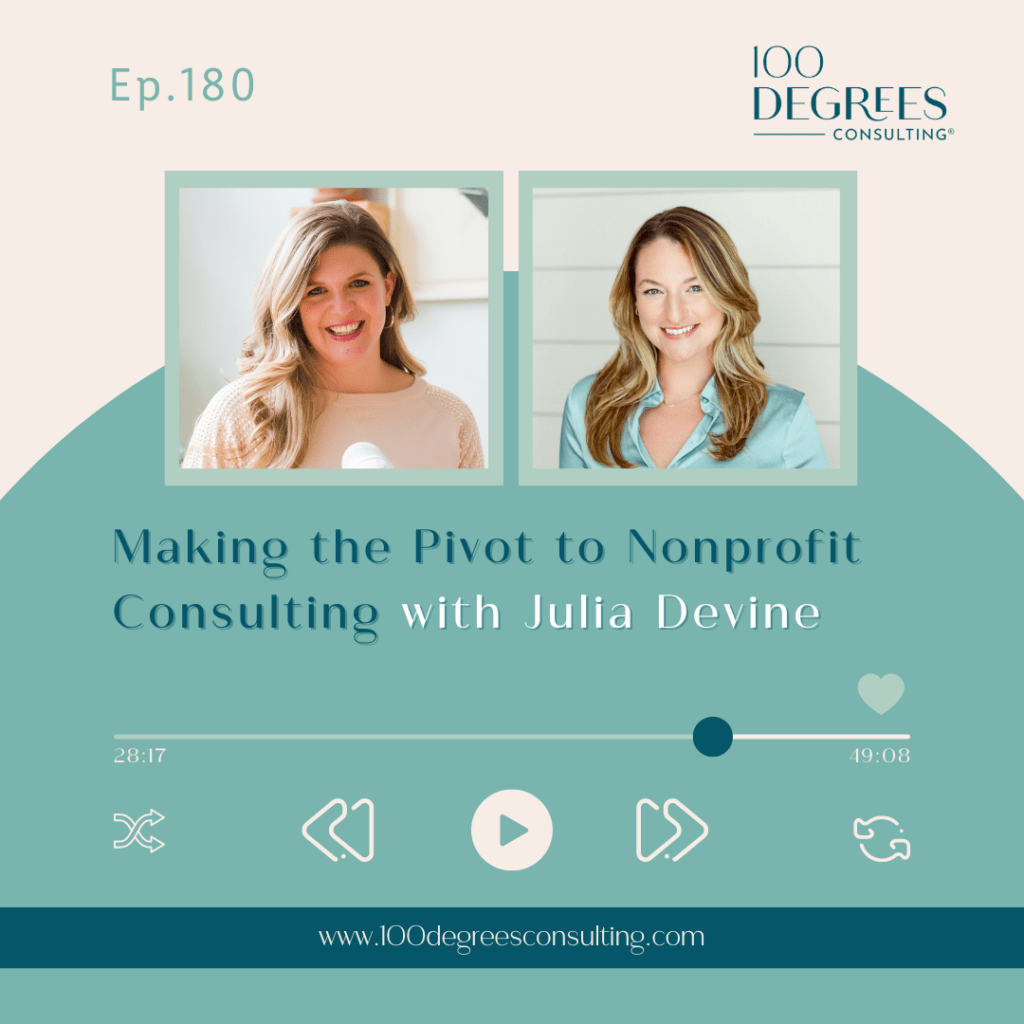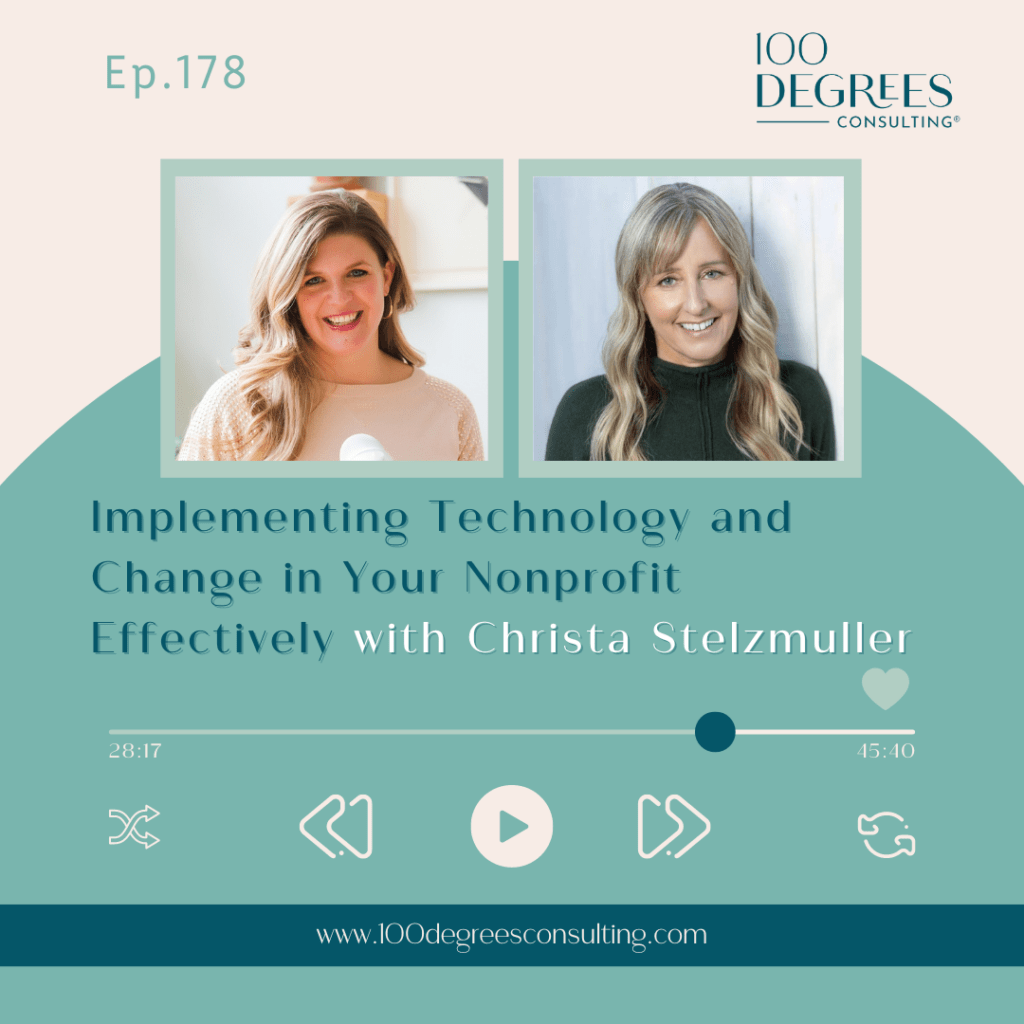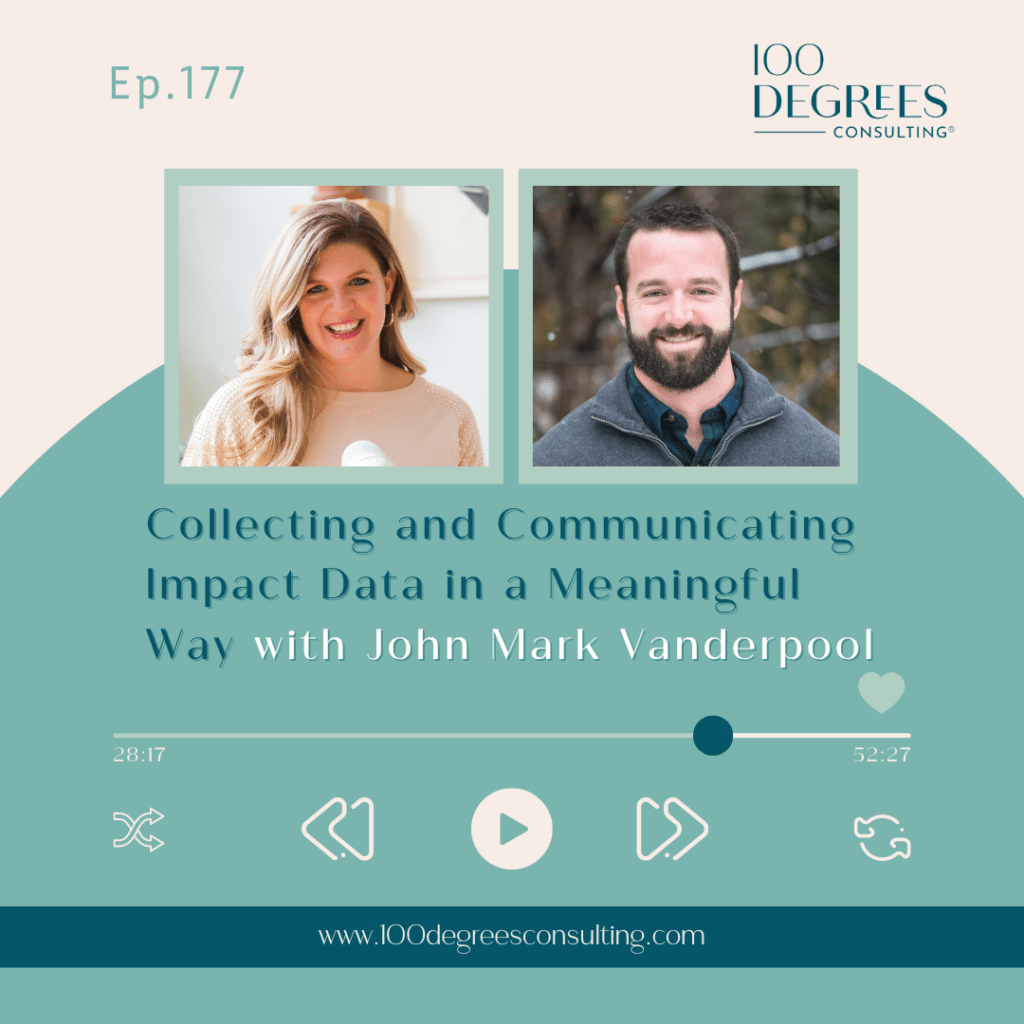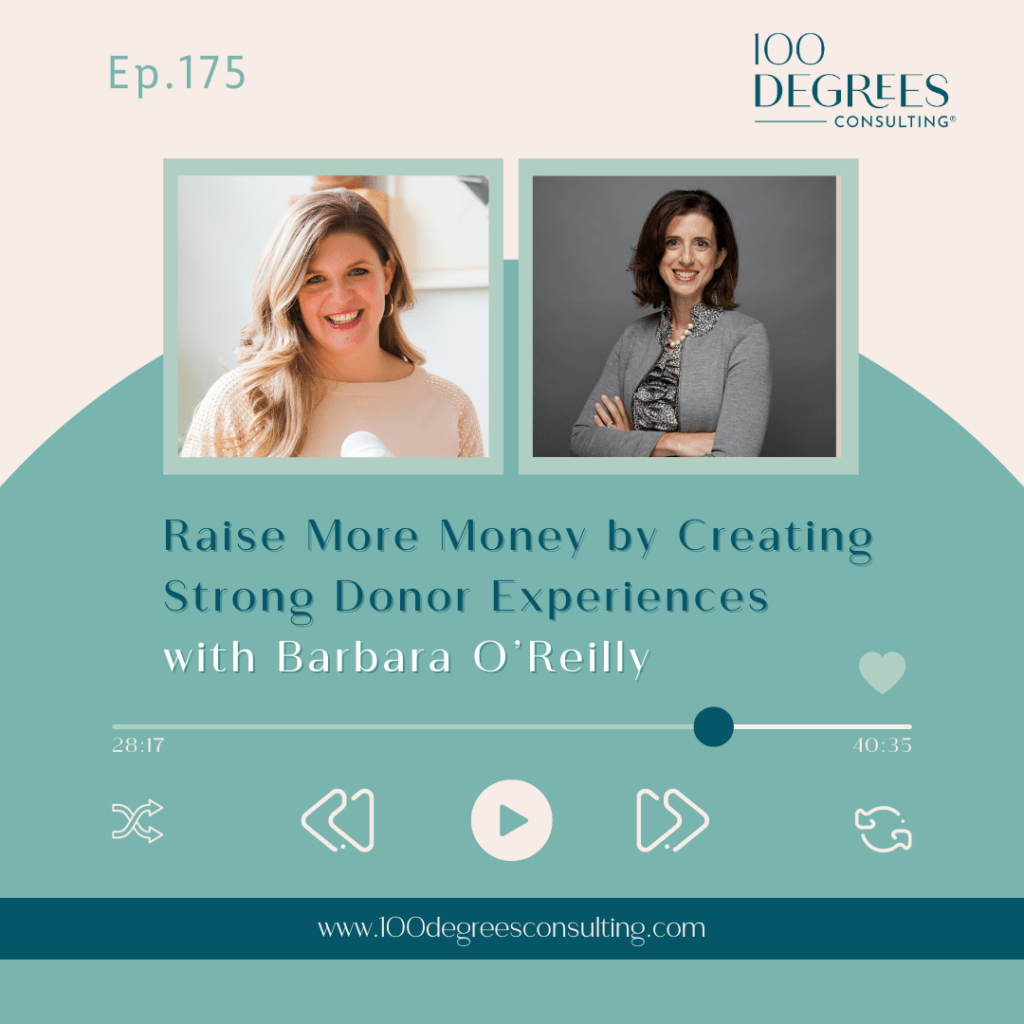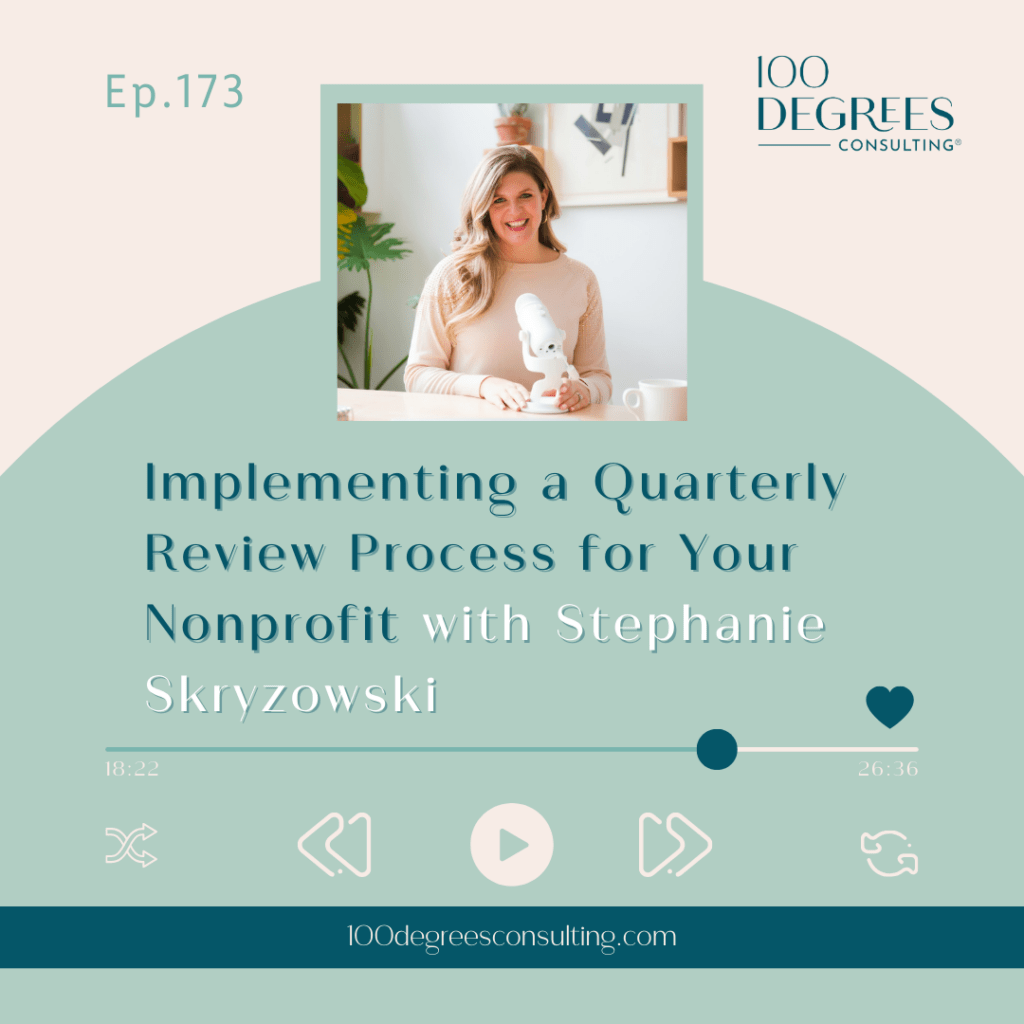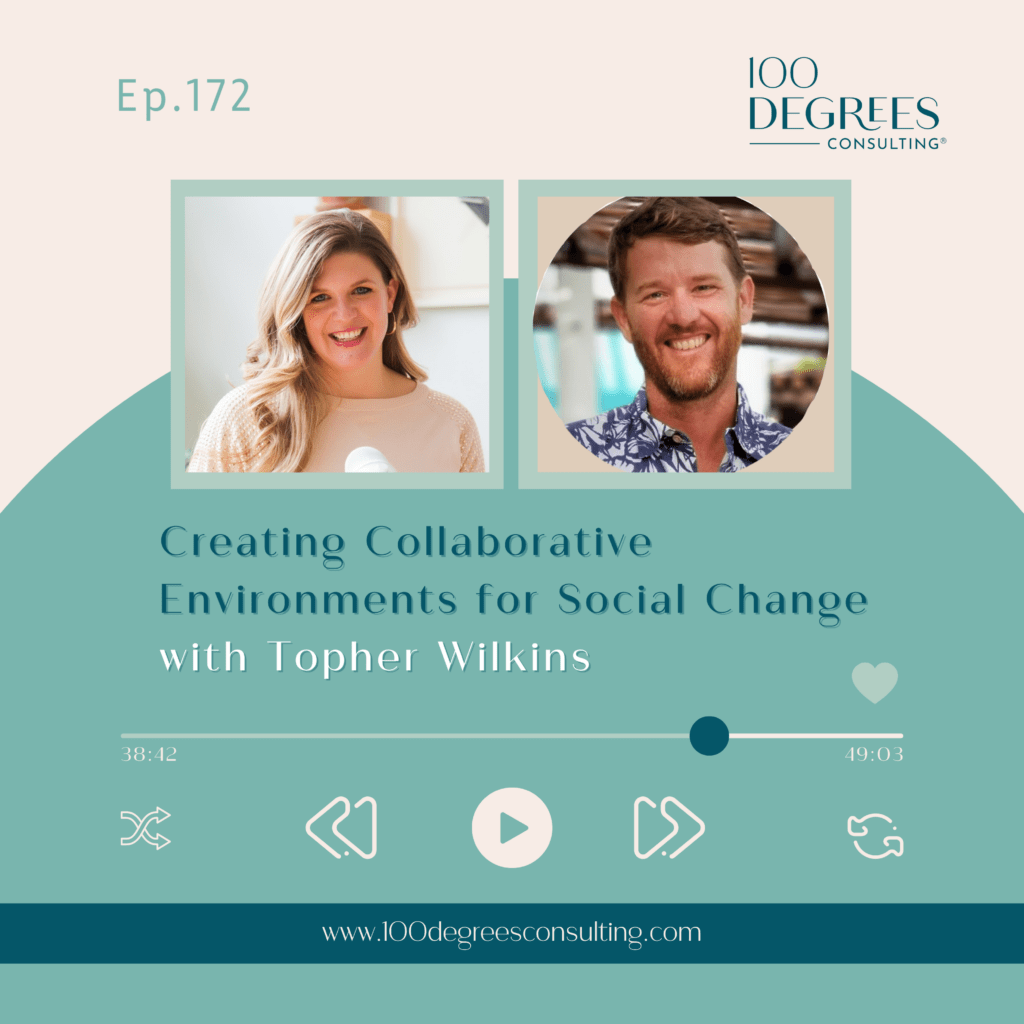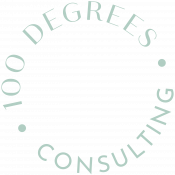Transcript Episode 178 – Implementing Technology and Change in Your Nonprofit Effectively with Christa Stelzmuller on The Prosperous Nonprofit
[00:00:00] Stephanie Skryzowski: Welcome to the Prosperous Nonprofit, the podcast for leaders who are building financially sustainable and impactful nonprofits and changing the world. I’m Stephanie Skrzewski, a chief financial officer and founder and CEO of 100 Degrees Consulting. My personal mission is to empower leaders. To better understand their numbers, to grow their impact and their income.On this show, we talk to people who are leading the nonprofit sector in new, innovative, disruptive, and entrepreneurial ways, creating organizations that fuel their lives, their hearts, and their minds. And their communities. Let’s dive in.
Hello friends. Welcome back to the Prosperous nonprofit. I am your host, Stephanie s Kowski. Today I have Krista Steler on the podcast, and Krista is the CTO. That’s Chief Technology Officer of Charity Water, [00:01:00] a nonprofit organization that we have probably all heard of. They offer clean drinking water to individuals in developing countries.
Since 2006, charity Water has relentlessly pursued its goal. of ending the global water crisis fueled by optimism, collaborative efforts with local partners and the generosity of supporters aiming to ensure universal access to clean water within our lifetime. And about Krista, throughout her career, she has consistently applied a multidisciplinary approach using data and technology to drive better decisions, products, and delivery.
With a strong focus on innovation and mission driven work, she excels in translating vision into strategy. Effectively communicating with diverse stakeholders and fostering productivity through collaborative leadership. And today I’m so excited to talk to her about working in new, innovative, disruptive, entrepreneurial ways.
And I think that’s what we all know and admire about Charity Water. And so we talk about that and really what her role as a CTO looks like, because [00:02:00] friends, I’m going to be honest with you. I don’t know any CTOs. I don’t know any organizations, no nonprofit organizations that I work with have a chief technology officer.
So I asked her to break it all the way down for us and explain exactly what she does. I’m like, do you manage the CRM? Is that your job? But it’s so much bigger than that. And so I love her holistic approach to implementing technology, both internally and externally at the organization. And it’s so interesting.
We kind of wrapped up the conversation thinking about like, okay, organizations who are getting bigger and maybe more complex, how do they know when it’s time to think about hiring a CTO? And so we talk about all the things in between. I think you’re going to really enjoy this conversation with Krista.
So without further ado, let’s go talk to her.
Hey everybody, welcome back to the Prosperous Nonprofit. I’m thrilled [00:03:00] to have on you with the show today, Krista Stelzmuller, who is the CTO of Charity Water, a nonprofit organization that we have probably all heard of. I know our listeners are deep in the nonprofit sector and Charity Water is one of those organizations that we all know and love.
So Krista, welcome to the show. Thank you. I’m
[00:03:18] Christa Stelzmuller: so excited to be [00:03:19] Stephanie Skryzowski: here. So I love to start all of our episodes by learning a little bit more about you, our guest and really understanding your journey. How did you get from the beginning of your career or what you thought you might do to being the CTO of a really large nonprofit organization?And I’m asking about your personal journey because I know that sometimes our journeys are not linear, right? We’re kind of winding all over the place. And I just think it’s so great to hear. The paths that other people have taken that really encourages our listeners, like, okay, just because I’m not exactly where I want to be right now, it doesn’t mean I can’t get there.
So share a little bit with us about your journey.
[00:03:59] Christa Stelzmuller: Great. [00:04:00] Well, I think I have a journey that starts probably pretty similar to lots of people’s journeys. I Started, uh, graduated from college. I did not actually leave college with a degree in computer science. I left it with a degree in political science because I’d always imagined myself working in some space oriented around either civil service or social good, some aspect of that.And after college, I Went on an internship and I was interning at a non profit and it was sort of kicking off what I thought was going to be the start of a career potentially in this space. And what I realized very quickly was that I couldn’t afford that. And so generally it was, I, I, I stayed there. And I learned some valuable things and it just ended up being a situation where I was not going to be able to [00:05:00] support myself going forward.
And I think that’s a hard choice that a lot of us face, especially when deciding to try to work in a sector that is focused on making social impact versus making a profit. And it just changes the dynamic of what things look like. And so it was actually a time in history that Technology was really starting to boom and I left my internship and I came home to Southern California.
I live in Southern California, came home to Southern California and I started with Deloitte Consulting and started in their technology group and they were needing so many people and The need for engineers was great. And so I had an opportunity to basically switch my career focus. I’d done some focus on mathematics and computer science when I was in college and younger, and it still felt like a solid [00:06:00] area for me to focus.
And that’s what I did. And that kind of launched my career in technology. And then. The dot com era took off and I really, um, aligned with that. And I spent about 20 years working in startups as I was progressing through that career. I kept trying to get closer and closer back to what had originally mattered to me.
And so in startups, I started working for mission based startups. And then when I was leaving the last startup I was at, I was looking at B Corps. And I said to myself, why not just go the whole way? Why not go back and actually work at a nonprofit again? And I. I asked myself, I said, there must be nonprofits out there.
It’d been so long since I had really looked at the sector and I wanted to ask myself, were there nonprofits out there who could use someone with a set of [00:07:00] skills, like I had one that was the skills that come out of. High growth environments and really working in scrappy ways. And I just assumed that there must be nonprofits out there that would be looking for someone like that.
And so that’s how I started my search and eventually landed on charity water. And that’s what brings me here today.
[00:07:23] Stephanie Skryzowski: Amazing. I love that path. And it just, it reminds me, I just read a book called the algebra of wealth by Scott Galloway. And he talks in that book about how we’re told to follow our passion.Um, but what is really important, what you really, you should do is follow your talent. And so I, it sounds like that’s, that’s really what you did. You know, you started off with your, Your passion in the nonprofit space. And we’re like, okay, well, I need to, you know, pay rent and eat. And so I need to follow my talent instead.
And I love that by doing that, you’ve actually been able to come full circle [00:08:00] back to your passion. And so I think that’s fantastic because again, I just think that so often in the nonprofit space and elsewhere, of course, we are told to follow our passion, but that means that, you know, we are basically living in poverty and that’s just not doable for most people.
So. I love that journey. And so tell us a little bit about for, you know, the maybe 1 percent of our listeners who have never heard of Charity Water. Tell us a little bit about Charity Water.
[00:08:25] Christa Stelzmuller: So Charity Water is focused on bringing clean water to those communities who need it. And we are focused squarely in the geographies of Africa and Southeast Asia today.And so we are really looking at communities that For whatever reason are lacking basic access to clean water and basic access means more than 30 minutes away from a water source. And that water source may yet still be contaminated in some fashion. And so that’s we’re focused on [00:09:00] reducing the number of people in the world today who are living without basic access to clean water, which right now is about 703 million people.
I think we’re the last official numbers. Stop.
[00:09:13] Stephanie Skryzowski: Wow. Yeah. And Charity Water has really sort of grown in its fame, its infamy, I don’t know, for this What do you call it? The, you have a name for it. All of the notations go to programs. [00:09:25] Christa Stelzmuller: It’s the 100% model. Yes. That’s it. Yes. Thank you. That’s it. 100% model. Yes.Scott, when he was starting out, realized very early on that there was a lot of distrust of charities overall and a lot of concern that if someone donated to a charity, their money would not be going. Actually to make the impact that was expected. And so he decided on a model at that time called the 100 percent model that allows [00:10:00] a segregated group of private donors.
To fund all of the operations so that everyone else who is donating to charity water can feel confident that their dollars are going 100 percent into providing clean water to a community that needs it. And so from there, it translates into everything else we do where we prove every project we’ve put in place.
Published every water point that we’ve ever put up and we don’t just focus on putting up new water points. We focus on maintaining the functionality. Of those water points over time. And so that always feels harder to communicate is that water infrastructure is not just a one and done. You don’t just put it in and walk away.
You have to put it in and make sure that it continues to function over time and that it continues to provide the service that is required by those communities who now have water for the first time. So, That model the 100 percent [00:11:00] model is still a core part of everything that we do. It factors into decisions we make every day around how we’re going to be talking about something or a new feature we might be building on the website.
We make sure that we understand exactly how those dollars are going to flow and make sure that they can come around and to an impact reporting experience. That makes sense. For our donors.
[00:11:27] Stephanie Skryzowski: Yeah. Yeah. Thank you so much for sharing that. And so you are the CTO, the chief technology officer for charity water.And I want to take a step away back for a moment and. You know, a lot of the organizations that maybe are listening, they definitely do not have a CTO on staff. Charity Water is a very, very large organization. And so the small and medium sized organizations don’t have a CTO and perhaps don’t know what a CTO does.
So can you tell us what’s in your job [00:12:00] description? What do you do as the CTO of Charity Water?
[00:12:02] Christa Stelzmuller: Sure. Maybe I’ll share a little bit of how it’s. different from a CIO type position, which I think maybe a lot of nonprofits are probably familiar with. So technology, I think we all know is a core part of what we need in order to function, whether it’s fundraising or whether it’s technology in our programs.We need technology to help us make the impact that we’re going to be making. There are two ways to look at that. The typical way I think that at least that I encountered when I was talking to a lot of nonprofits when I was first out there searching is looking at technology like a cost center, which really puts it in the bucket of being this necessary evil.
We all need our CRM to do To manage our donors. We all need our email systems so that we can send out our communications, but really not thinking about those as much more than a cost [00:13:00] center. A CTO is focused in a slightly different area. It’s not just about bringing, um, services, although it is a purview of a CTO.
It’s not just about bringing services. To the different business teams that might exist inside of a nonprofit. It’s also about being a revenue driver. And so that when charity water was looking for a CTO, they were looking for someone who could manage, not just the it function, but an in house engineering function and a product function and a product design function that very specifically works on developing new experiences.
And those new experiences. Are really rooted in marketing and fundraising for the most part, at least today at charity water, but there’s also technical aspects of what needs to happen on the programmatic side. We have a sensors program today. That’s deeply rooted in [00:14:00] technology investment that charity water is making.
And so there’s a wide range of where. Technology can actually be used, but I would say the core of it is like looking at it from the perspective of, is this a cost center or is this a revenue driver? Am I part of the revenue driving picture or, or am I just an expense that I have to account for? And Charity Water very much set technology in the here to help us drive revenue and programmatic impact camp.
[00:14:32] Stephanie Skryzowski: That is so interesting because I, I was thinking about it and I was like, yeah. I could see the, the need for, for somebody to manage our sort of internal IT systems, but I was thinking that because Charity Water does have so much technology involved in your projects that I was wondering if there was a, a programmatic aspect of your work as well.And so it does your work as a sort of revenue driving unit. How does that help [00:15:00] diversify Charity Waters revenue streams? I would imagine that, you know, you’re getting contributions obviously from individuals and probably foundations. And, um, does your work basically add onto those type of revenue streams or do you have another revenue stream that you’re able to just help diversify the overall revenue pool of the organization?
[00:15:19] Christa Stelzmuller: So I think technology works like similar to how it works. And I think a for profit organization. It’s really, I like to say that charity water is both a direct to consumer and a SAS software as a service business at the same time, right? And so any of the team that is focused on direct to consumer is focused on highly digital experiences, right?And reaching audiences and mass. And so our technology efforts on that side are really around developing Martech and making sure that we have a website. We are focused on very [00:16:00] similar things that you might be focused on in e commerce, like a conversion rate and a retention rate and all of those types of things.
And then on the flip side, when we’re working with Those audiences that you were just talking about, whether they’re brand partners or other types of major donors were really focused on operating more like a software as a service. We have a fundraising team that needs to be supported, and whether it is bringing up some type of experience around a major event that charity water is putting on, or whether it’s just supporting those teams and making sure that they’re doing their outreach.
As effectively and efficiently as possible, like whatever the needs are, we’ll step in from a technology perspective and attempt to support those.
[00:16:51] Stephanie Skryzowski: I love the way that you’re sort of thinking and speaking like a business where the rest of us, where a lot of [00:17:00] other smaller nonprofit organizations need to go and need to think.And one of the questions that I love to ask is how are you working in new or innovative or disruptive or. Entrepreneurial ways in the nonprofit sector. And I, you know, I’ve read Scott Harrison’s book thirst, and I’ve listened to him speak quite a bit. And I know he thinks very differently than largely the entire nonprofit sector in a good way.
I think he. Thanks. Really, really big. And, um, and he thinks really creatively and I would imagine that that sort of permeates throughout the culture of charity water. But I would love to hear, you know, from your experience, I know you’re like relatively new ish to charity water, right? Like just over a year or so.
Yes. That’s right. Yeah. So I would love to hear, you know, from your perspective, how is the organization working in new, innovative, disruptive, entrepreneurial ways within the nonprofit sector?
[00:17:52] Christa Stelzmuller: Well, I would think right now, maybe a few things I can mention, you’re absolutely right about Scott. Scott, I think continues to [00:18:00] be someone who is pushing the envelope in terms of thinking, but I think if we put the root of like how and why we innovate, it comes down to experiences.And so right now, Charity Water is working on Maybe something that is not as well known or is a in person experience around trying to bring the experience of what it might feel like to not have clean water. readily accessible and having an in person experience around that where we can introduce folks to using technology to be able to interact with people who are living in very different parts of the world and living very different experiences and using technology to create and We can’t truly replicate these experiences, but build some empathy through a shared [00:19:00] experience of some kind through an actual physical space.
And so, uh, physical space, a retail space, effectively, that allows us to introduce folks to charity water overall. And. The experiences of the people that we’re trying to serve, I think, is a core part of where we’re focused in innovation right now. We’re always focused in innovation in different ways, right, that that one is more around experience and really rooted in that experience.
We have a sensors program that’s been going on for quite some time, which is. One of those programs where there’s a white space, it’s a white space that exists around the ability to monitor and evaluate the performance of water points, right? And this continues to be an important element of Charity Water’s belief that things must be sustainable.
And filling this white space, it required us to actually dive in [00:20:00] and innovate in the space of sensors, so that we could actually understand. Things in a way that were not possible normally where we can find off the shelf solutions. We will always try to find those, but if they don’t exist, we are left with either giving it up or innovating ourselves.
And generally we choose to innovate ourselves if we can.
[00:20:24] Stephanie Skryzowski: I love that. And you know, I think that’s really interesting because I think a lot of nonprofit organizations might like to do that, but don’t have the resources behind them to be able to do that. And I think Charity Water. You know, today is of large enough size has built a really significant donor base who understands your model and your culture and the way that you work, that like, it’s okay for you to experiment and build something yourself.I feel like a lot of smaller organizations don’t have that ability, that privilege. Um, And so what would you say or maybe what advice might you give to a smaller organization [00:21:00] who’s like, yeah, we really want to be able to do this, but like, I just don’t, we’re no charity water. I don’t see how this is possible.
Right. Yeah. Do you have any like thoughts or words of wisdom for them?
[00:21:09] Christa Stelzmuller: Well, maybe I’ll just share my own experience. So I also try to volunteer and I volunteer with a small organization in my community who faces exactly what you’re talking about. And generally the choices I make there. They’re the same in one respect and they’re different in other respects.When it comes to technology, I try to do as much with them. That’s off the shelf as possible, right? Because this is not the time at that stage of an organization to be investing a lot in developing things on your own for very basic commoditized functions. Right? So whether it’s your donation form or whether it’s your website, use a pretty standard CMS.
That’s where like one piece of advice is like just use what’s out there and try to focus on the things that [00:22:00] deliver the best experience for the lowest cost that you can and so that’s going to be the thread that I tie in there is like experience on the flip side where. will try to innovate, like where I will work with them to try to innovate a little bit, is on that experience side.
It’s like, what events can you do that are unique to the audience that you’re serving and unique to your mission in some fashion? What stories can you tell that are stories that may Not be heard or as common that you were uniquely in a position to tell. And so innovation isn’t always about, yes, technology is innovation.
Yes, you can have an innovative business model, but you should also be innovative in your storytelling. And that doesn’t really cost anything, right? It’s really about thinking about what those experiences can be [00:23:00] and focusing in on delivering. The best experience you can for the place that you’re at at a moment in time, and so it’s really about listening to your audience, and that’s your donors and the folks that you’re trying to serve, whatever your mission is, and then really diving in on what experiences make the most sense.
[00:23:24] Stephanie Skryzowski: I love that because I think that, you know, a lot of people look up to charity water and we all see on Instagram and social media, like your amazing creative gala events. And I think probably some organizations get kind of discouraged thinking like, Oh, well, we’ll never be able to do anything that cool.But I think it’s like the core principles that you just brought us back to around storytelling and creating an experience that is meaningful for your people where they are. It doesn’t necessarily mean like, I don’t know where you hold, but like renting out the Javits center and having this like, like, Massive [00:24:00] thing.
It’s the stories and it’s the experience that you create. It does it exactly. I would imagine like, you know, we provide financial services to nonprofits, CFO and bookkeeping services. And often when we come into a new client and we are proposing some technology to help them say, Pay their bills more efficiently instead of like printing paper checks and driving them across town to get somebody to sign them Um, you know, we’re proposing software to help them with some of these we are often met with like Well, this is the way we’ve always done it And I would imagine to some degree like that’s not really a phrase that anybody really speaks at charity water.
Am I right?
[00:24:39] Christa Stelzmuller: You know, I would say it yes and no. I think that that’s normal for people It doesn’t matter what stage of growth you’re in You There will be a moment where change is going to be hard, even if you’re a large organization. In fact, I think the larger you get, the harder change can actually [00:25:00] become.This is one of the great things about being small is just being super nimble all the time. The larger you get, the more you have to persuade around change, right? And so I would actually say that the phrase This is the way that we’ve always done. It is something that we hear all the time. And it means that at a larger organization, you have to focus a lot on change management generally.
And so you don’t want to give up that feeling of innovation. You don’t want to. It’s very easy to sort of settle into your patterns over time. And it’s something where To push folks out of their comfort zone requires more coordination and more work, the larger that you become. And so I would actually say it’s a thing I hear for sure.
And it’s a thing to take seriously and manage around if you want to maintain a culture of [00:26:00] innovation going forward.
[00:26:02] Stephanie Skryzowski: Mm hmm. Yeah. Yeah, absolutely. That’s a great point about like, yeah, if we are changing now, we got more people to convince of the change. Like even if we’re like generally open to it, we have more people to bring with us on that journey.So yeah, that, that totally makes sense. That’s right.
Are you tired of navigating the labyrinth of social media? Okay? If you’re looking at your banking software options, wondering what works best together and how to afford it all, it is a dizzying task from choosing the right accounting software to ensuring seamless integration between all the systems.
Feeling lost in the jargon? Absolutely not. Fear not introducing the best tools for an efficient and prosperous nonprofit. This free resource is a curated collection of top notch software solutions personally endorsed by our team at 100 degrees consulting. Visit 100degreesconsulting. com slash tools to access our handpicked list designed to [00:27:00] streamline your operations and boost your nonprofit success without Adding a ton of extra cost or extra team.
Don’t miss out. Head to 100degreesconsulting. com slash tools now to download the best tools for an efficient and prosperous nonprofit. Let’s elevate your nonprofit to new heights.
So what opportunities do you see for. to embrace technology, especially if there is that, like, this is how we’ve always done it or they don’t have a CTO. They don’t know where to start. Um, what opportunities do you see for nonprofits to streamline their operations or raise more money or improve their programmatic impact, um, using technology that feels like, um, Maybe not a giant leap across the Grand Canyon.
What opportunities are there?
[00:27:53] Christa Stelzmuller: I think if I were to focus on one thing, because it’s a thing I have run into repeatedly in [00:28:00] different places, is think early and often about your data. And what matters to you about your data setting that foundation well early will save you so much time and energy later on if you actually and I’m really just talking about the core things that that matter your CRM whatever that is.However you manage it, whether it’s managed in a spreadsheet or whether it’s managed in Salesforce, those are the two extremes in my mind, right? You want to make sure that you’re focused on high quality data and high quality. Information that you can use to develop over time, and it’s the same. I think in programs for us, monitoring and evaluation is very important.
Right. And setting the foundation for having. [00:29:00] A high quality data environment enables you down the road, you won’t be able to do everything that you might imagine doing with it right away, but it sets the foundation for a lot of capabilities as you grow going forward.
[00:29:16] Stephanie Skryzowski: Yes, and I always recommend, you know, when people are asking me about like, well, when should I, um, set up my accounting system or when should I like really make sure my accounting system can track on this granular, like right now, if not yesterday, today, exactly.Because you don’t want to get a year down the road and like, oh, I wish I had that data from a year ago or even worse be faced with like some massive cleanup project. Because you need the data and now you have 365 days worth of information to sort through and, and categorize and analyze and all of that.
So I love that. I think that setting your systems up today is going to serve the organization that you want to be in the future. Um, so I, I completely, yeah, I completely [00:30:00] agree. I love
[00:30:00] Christa Stelzmuller: that. I can completely see how in finance you would, it makes so much sense. And I would say your financial system for sure is the most important place to start. [00:30:11] Stephanie Skryzowski: Yeah. And speaking of that, obviously we’re, we talk a lot about finances on this podcast. What is your role as CTO with like the accounting software and the financial data and how that, you know, speaks to or ties in with, um, other data and information and systems in the organization? [00:30:28] Christa Stelzmuller: Oh, sure. Um, well, we have a model, I think, where I would put our CRM in the center of everything.But as the CTO, we’re really responsible for making sure that we have multiple systems where the same data needs to exist in those different systems, whether it’s our GL or whether it’s our CRM or whether it’s our email. Systems, right? It needs to exist in all of these different systems and it needs to be consistent.
And so, as one of [00:31:00] the things that my team actively manages is the integration across all of these systems. And so, that’s a big part of our engineering focus is just making sure that We have consistency and integrity and making sure that if we’re generating a tax receipt out of one system and someone is generating that same tax receipt through their self serve online experience that we are consistently managing that.
And so sometimes that means running it out of the same place. Sometimes it means having data in the same place. And so we make a lot of decisions about both which experience is best suited. To a particular audience and then which technology we should be running it out of and then making sure we have the data consistent across those systems.
[00:31:48] Stephanie Skryzowski: Yes. I remember working with one organization who was considering a, um, a switch to their CRM and they were Involves the finance team and the beginning [00:32:00] conversations and we were able to provide input on like this is what we’re going to need out of the CRM because we for our audit, we need to be able to reconcile the two systems.So we need to be able to do XYZ. And then we never heard anything for like months and months and months. And all of a sudden it was like we have this brand new system and the finance team found out. Oh, it like is not going to be able to integrate the way that we needed and it can’t do what we thought it was going to do.
And we’re like, wait a second, what happened? We were a part of the conversation and then like no more. And so now we found out that these systems don’t talk to each other and it’s going to be a lot more manual work for us. And you know, all the things. And so how do you sort of create this environment and culture internally where, you know, the technology really is a collaborative process and maybe not necessarily like group decision making, but you’ve got group input.
How do you sort of foster that? That is, that’s so important to make sure that everybody is kind of on the same page about all these systems that we work with. [00:33:00]
[00:33:00] Christa Stelzmuller: Oh, I totally agree. I think it starts in like spending most of your time up front. In planning, and I completely recognize the scenario that you just described, and I think that that’s pretty common, and it happens when.You start to talk about change, and then sometimes that change can feel very scary up front, but if folks basically disengage because it feels scary up front and they think, okay, I’m just going to go off in my silo and do this on my own, you’re 100 percent right, you’re never going to get the right outcome at that point.
The, the real key is to stay engaged with all of the teams. Because those teams are there and they’re going to bring friction, no matter what, right? Like friction is there for a reason. It’s so that we can get the best outcome. We’re actually in the process right now of restructuring some of our key data points, which, which do impact our [00:34:00] financial revenue classifications as well.
And we’ve spent months at this point, and I don’t mind saying that because it’s this type of planning. Takes a long time to do because we have to think about year over year analysis and what that’s going to look like and how our financial reporting might change, et cetera. So I would say you have to spend a lot of time in planning and definition, spend way more time in planning and definition and.
Alignment, then you actually spend an implementation. I think a lot of folks want to jump to implementation right away. They feel like I have this goal. My goal is to get this CRM updated. I’m going to make this happen. And that won’t be successful if you haven’t done all of the work to make sure everybody is Aligned and marching toward the same goal.
Your CRM sits in the center of everything. And so [00:35:00] every dependent system on it, you need to be talking to every single one of those dependent systems and making sure that you’re not effectively screwing anything up downstream. And that takes time and it takes intention. And so I would say, don’t be afraid of doing 80 percent of your time in planning and prep and only 20 percent of your time in implementation.
Don’t jump to implementation too quickly.
[00:35:27] Stephanie Skryzowski: Mm hmm. I know we’re all just like, Oh, we just want the results. We just want, like, I want to make this happen. I know myself, like with tons of projects at work, I’m like, I, I, Just want to do this. I want to get it done. I’m sick of thinking about it and talking about it.I just want to take action. And I have really had to slow myself down and think like, am I doing this the right way? Like, and really question myself, am I doing this the right way? Could I do it faster? Yes. But is that the right way? And I’m writing a book right now. That’s a big part [00:36:00] of like, yeah, I could self publish this thing in like two months and be done with it.
But is that really what I want for this book? No, it’s not. So I’m having to really slow down and go through the process and it is testing my patience, but It’s the right thing to do. So yeah, I think that is such, such good advice because you’re gonna have less cleanup later. You’re gonna have more people bought in, on board with whatever changes you’re trying to bring.
I would imagine that like, I don’t know, I feel like we’re talking a lot about change. You’re almost like a, you know, sort of a change management. You have to be a little bit of a change management expert working in, in technology because things do change quickly and you do have to get a lot of people involved.
on board and I know that’s not your necessarily your like educational background, but do you have any like change management tips for us as we’re trying to get people on board with, with new ideas?
[00:36:50] Christa Stelzmuller: Yeah, for sure. I mean, I rely on a lot of frameworks that other folks have put down over time, right? And so right now, the one that’s top of [00:37:00] mind for me is in, uh, One of the radical candor books and it’s the collaboration wheel and I feel like the collaboration wheel is a great framework for really talking through that whole series of steps that needs to happen to execute effective change management.I mean, I’ll just share a personal story. I was Even the other day I had been working this one problem and I thought I had done all of the change management well and then I was like, you know, I think I could have done better on the persuade side of the camp here because for whatever reason. Games of telephone, especially when an initiative is large, this game of telephone happens and you have to constantly be working against this game of telephone.
It’s like there’s no great handoff of the requirements. There’s none of that type of stuff. When you’re managing change, it’s an [00:38:00] all in process from beginning to end. And you have to be involved and engaged and persuading from beginning to end. The very start until the very finish, and it can feel exhausting.
I think for folks, if they think about it, I think that’s why a lot of change management sort of falls by the wayside is sometimes it can be. Exhausting to do all the things that are necessary to successfully manage change, but we have to make that commitment to it. So I guess that would be my tip is you don’t get to walk away once you have at least someone like myself like week.
I could sit here in strategy all day long and. Not think about and feel like there’s a handoff moment. And that’s not how I can effectively manage change. I have to be in it with the team from beginning to end.
[00:38:54] Stephanie Skryzowski: Yeah. I think that too is just like that idea of doing something the right [00:39:00] way. Could we bulldoze forward and just do what we want to do and deal with the aftermath of that?Later. Sure. But like, is that really what we want? Is that really the right way to accomplish whatever we’re trying to do, whether that’s implementing, you know, a new software technology or anything else? Like, is that really the right way? Is that really what we want to do? And so I think it’s making sure that we are committed to doing things the right way.
That’s fantastic. So A couple more questions before we wrap up. So when might an organization need a CTO? What would you say are like the qualities or the size or the complexity of an organization that might sort of trigger them to think like, Oh, okay, we might need a CTO.
[00:39:46] Christa Stelzmuller: I think anytime you start getting into, I mean, it’s going to depend on the organization, how the organization is structured, but my bias will be toward a CTO product led type [00:40:00] organization.And I guess what I would say is anytime you find yourself running into a situation where you’re really trying to unwind a business process and develop. A really strong business process around something and then it’s the combination of that business process and then finding the right technologies to support that business process.
I think about that very much through the lens of thinking of all of our business teams as users. And so I think you can take that lens and say, okay, everyone in my team is a user today. And if I think about them as an audience and I think about what their needs are, how do I start filling their needs?
Then you might be thinking about a CTO type role. Then you might be saying to yourself, this is a place where I might go product, And engineering versus a more traditional CIO route. So it’s but I think it really comes down to what the [00:41:00] organization is more comfortable with overall. But that’s how I would I would lean it if you’re thinking business process.
And you’re thinking, how do I meet the needs of that business process through technology? You’re already thinking like a CTO is thinking.
[00:41:17] Stephanie Skryzowski: It’s so interesting. I mean, most of the organizations that my company works with, I do not have a CTO. So this is a great conversation for me as well, because it’s not a position.In a nonprofit that I have a lot of experience with. So I love chatting through this with you.
[00:41:33] Christa Stelzmuller: Yeah. I think a lot of folks think a CTO is really only there for the externally facing technology. Like that’s the part that I’m trying to highlight a little bit as sure. If you have a website and you’re developing experiences right now, you’re classically in the product and engineering.Mindset, but it goes beyond that. You can think of your internal teams as users as well. And so again, this is my bias as a [00:42:00] CTO. How I start to think about it. I don’t think you have to wait for what are my external experiences going to look like. You can also think about your internal experiences and what they should look like.
[00:42:12] Stephanie Skryzowski: Mm hmm. Yeah. Because with a large organization, like you said, there’s a lot of stakeholders there that we need to kind of consider. And yeah, I think that’s, I think that’s a great point. Well, the last question I have for you that I like to wrap up all of our interviews with is what does a prosperous nonprofit look like to you?Ooh,
[00:42:32] Christa Stelzmuller: this is a good question. I think a prosperous nonprofit to me looks like a nonprofit that is able to invest in its growth. And is putting some emphasis in terms of how to grow because we are focused on delivering maximum impact. And so if we are treading water, [00:43:00] or we feel like we’re not able, if we’re doing the same thing year over year, we’re probably not feeling at least in my mind, that doesn’t feel like the prosperous nonprofit, the prosperous nonprofit is the one that’s focused on growing its impact.And so is able. To put some of its resources behind growth in some capacity. And then I would say on the flip side, sort of the internal people side, the Prosperous Nonprofit is one where it’s focused on people development, that there’s an element that we can set aside to help grow the folks, because we have, as you said at the very beginning, the passion.
There’s so much passion in our sector, and we want to help focus and develop that passion into being real leaders over time and real experts in our field. And I completely understand the desire to focus almost [00:44:00] exclusively on impact. If we can, because that’s what we’re here for. But we also have to focus on our people and making sure that we’re developing expertise and those folks.
And so to me, the prosperous nonprofit looks like someone focused on both growing impact and also growing their people internally.
[00:44:20] Stephanie Skryzowski: I love that. I completely agree. I don’t think we’ve gotten a single answer that’s the same as somebody else’s in like well over a hundred guest episodes. And so, yeah, I love that focus on the people and the impact.I think that’s, that’s fantastic. Well, Krista, thank you so much for joining me today. I feel like I learned a lot from talking to you. If our listeners want to learn more about your work or Charity Water, where can they And we find out more
[00:44:50] Christa Stelzmuller: to learn more about charity, water, um, charity, water. org. And we have loads of information on there that you can learn about.And for me in [00:45:00] particular, um, I’m on LinkedIn and folks can always find me there on LinkedIn and message me if they want to reach out and have a chat.
[00:45:08] Stephanie Skryzowski: Fantastic. Well, thank you so much. It was a great pleasure to talk to you today and listeners. We’ll catch you next time. Thank you so much for having me.Before you go, I just want to thank you for being here. To access our show notes and bonus content, visit 100DegreesPodcast. com. That’s 100DegreesPodcast. com. And I’ll see you next time.


